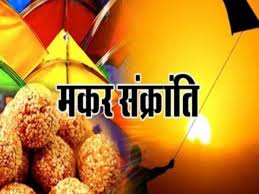Significance of Makar Sankranti
Although Makar Sankrant is a sun-reading festival, it has gained importance in Hinduism from many perspectives. As festivals, festivals and vows have a spiritual basis, when they are celebrated, they create consciousness and thereby help even the common man to approach God. If you know the spirituality behind celebrating such important festivals, it will be more fruitful. Let us understand the importance of Makar Sankranti through some formula
Makarasankrant :* On this day, Sun transits into Capricorn. Every eighty years the solstice is moved forward by one day to compensate for the difference caused by the rotation of the sun. Uttarayana of Surya begins on this day. The period from Karkasankranti to Makarasankranti is called Dakshinayana
.Practical Significance of Makar Sankranti : In Indian culture, Makar Sankranti is celebrated to forget the quarrels and increase love. On this day, every soul approaches as ‘take tilgul, speak sweetly’. On this day, Tilgul should be kept in front of God before giving it to others. Therefore, the strength and vitality of Telagula is preserved. Giving tilgool awakens vitality and a different feeling in us. On a practical level, the soul benefits from the vitality of the home environment. His affection increases. It helps him to change from a negative perspective to a positive one.
Importance of Sesame Seeds :* Sesame seeds have more ability to receive and transmit Sattva Lahari, so consumption of Sesame Seeds improves Sadhana by introspection.
Significance of Makar Sankranti in terms of Sadhana:* On Makar Sankranti, the atmosphere is more lively from sunrise to sunset. The soul who practices Sadhana gets the most benefit from this consciousness. This consciousness helps to increase the brilliance of that soul. On this day, every living being should take advantage of that consciousness by generating more sattvikness without allowing the raja-tama in the environment to increase. The day of Makar Sankranti is favorable for Sadhana. So during this period, try to gain consciousness from God and Guru by doing more and more Sadhana
A time favorable to sadhana :*’The time of solstice is favorable to sadhana; Because during this period, there is a higher amount of Godly energy waves working related to the principle of Self and Tej in the
*Showing the way to One Brahma :* ‘Sankranti shows the way to move from duality to non-duality, i.e. to One Brahma, by practicing Sadhana through the Jiva body made up of five principles through the ritual of worshiping the earthen jar and giving up the trigunas.
Luminous period :* ‘On this day the gods descend on the earth to receive the offerings offered in the yajna. By this luminous path the pure souls leave the male body and enter the celestial worlds; Hence this period is considered to be enlightened.
Importance of offering Sesame-Rice to Mahadev on this day :* There is also a statement to offer Sesame-Rice to Mahadev on this day or to offer Arghya mixed with Sesame-Rice. Sesame seeds are considered to be of special importance on this festival day. The burning of sesame seeds, bathing in sesame water, drinking sesame water, offering sesame seeds, using sesame seeds in cooking, and donating sesame seeds are all sinful practices; Therefore, on this day eating sesame, jaggery, and sugar-mixed ladoos, as well as donating is of great importance. Makar Sankranti’s spiritual meaning is ‘bringing in the right revolution in life’
Significance of donation given on Makar Sankranti: *According to religion, the importance of donation, chanting and religious rituals on this day has been mentioned. Donations given on this day are received hundredfold after rebirth
*NATURAL FESTIVAL :* This is a natural festival, a festival in harmony with nature. Tamil year starts from this day in South India. There this festival is known as ‘Thai Pongal’. The Sindhi people call this festival ‘Tirmauri’. In Maharashtra as well as in Hindi speaking it is called ‘Makar Sankrant’ and in Gujarat this festival is known as ‘Uttarayan’.
Panchopachar in Haldi kunkva :* 1. Application of turmeric-kunku : Due to application of turmeric-kunku, the latent principle of Shri Durga Devi in Suvasini is awakened and benefits Suvasini who applies turmeric-kunku.
2. Application of perfume :* The sulfur particles emitted from the perfume appease the principle of deity and work for the perfumer in a short period of time (beneficial to the perfumer).
3. Sprinkling of rose water :* The fragrant waves emitted from rose water activates the deity’s waves and purifies the atmosphere and the healer gets more benefit from the sagun principle of the working deity.
4. Giving Vaan :* While giving Vaan, always give the end of the layer by supporting the Vaan. Vaan means surrendering to the divinity in another soul by relinquishing body, mind and wealth. To give support to the end of the garment means to learn to give up the attachment of the garment to the body and to renounce the flesh. Since Sankranti period is conducive to sadhana, the deity is quickly pleased by the incense offered during this period and the perfumer who gives incense gets the desired fruit.
* Which variety should be given? :* Instead of giving items like soap, plastic items, good luck items, incense, camels, pictures of deities, religious books, pots, etc. should be given which are complementary to spirituality
The second day of Sankranti is called Kinkrant or Karidin. On this day Devi killed Kinkarasura.
Team santoshbharatnews













